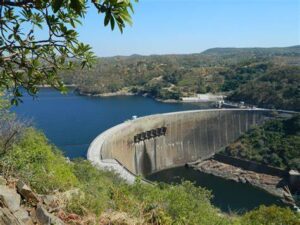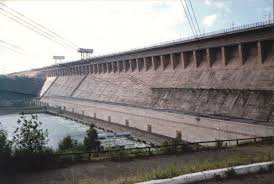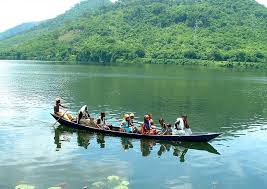Man-made lakes, also known as reservoirs, are artificial bodies of water created primarily by constructing dams across rivers. As water accumulates behind the dam, it forms a lake that can serve various purposes, including agricultural irrigation, flood control, recreation, drinking water supply, and hydroelectric power generation. According to the National Aquatic Resource Surveys, there are more than 53,000 man-made lakes globally, each varying in surface area and volume capacity.
The Largest Man-Made Lakes in the World
1. Lake Kariba (Zimbabwe/Zambia)
Lake Kariba, located on the border of Zimbabwe and Zambia, holds the title of the largest man-made lake in the world by volume. This enormous reservoir was formed by the construction of the Kariba Dam on the Zambezi River. Stretching over 223 kilometers in length and reaching widths of up to 40 kilometers, Lake Kariba covers a surface area of 5,580 square kilometers. It boasts a water storage capacity of 185 cubic kilometers, making it a significant source of hydroelectric power for the region.

However, the creation of Lake Kariba had its downsides. During its filling process between 1958 and 1963, the lake’s weight caused over 20 earthquakes with magnitudes above 5 on the Richter scale. More recently, in 2019, the region experienced severe droughts that reduced water levels and led to extended blackouts, some lasting up to 18 hours per day.
2. Bratsk Reservoir (Russia)
The Bratsk Reservoir, located in Russia, is the second-largest man-made lake in the world by volume. This reservoir was created by constructing the Bratsk Dam on the Angara River in Irkutsk Oblast. With a surface area of 5,470 square kilometers, Bratsk Reservoir can hold up to 169.27 cubic kilometers of water. The dam, which stands 125 meters tall and stretches 4,417 meters across, was completed in 1967.

The reservoir plays a key role in hydroelectric power generation, with a total capacity of 4,500 megawatts. Although not as expansive in surface area as some others, its immense volume places it among the top reservoirs globally.
3. Lake Volta (Ghana)
Lake Volta in Ghana is the world’s largest man-made lake by surface area, spanning a staggering 8,502 square kilometers. This reservoir covers approximately 3.6% of Ghana’s total land area. While it is the largest lake in surface area, it is third in terms of volume, with a capacity of 124,000,000 acre-feet of water. The lake was formed by the construction of the Akosombo Dam between 1961 and 1965, which harnesses the waters of the White Volta and Black Volta rivers.

Lake Volta provides Ghana with the majority of its hydroelectric power, making it an essential resource for the country’s energy needs.
4. Manicouagan Reservoir (Canada)
The Manicouagan Reservoir, located in central Quebec, Canada, is another massive man-made lake. The Daniel-Johnson Dam formed it when workers built the dam between 1959 and 1970 to impound the Manicouagan River. The resulting reservoir has a surface area of 1,950 square kilometers and a maximum depth of 350 meters. Its total water volume is 142 cubic kilometers, making it the fourth-largest man-made lake by volume.
This reservoir sits within the Manicouagan crater, one of the oldest known impact craters on Earth, which adds to its geological significance.
5. Lake Guri (Venezuela)
Lake Guri, located in Venezuela, is one of the largest blackwater lakes globally, with a surface area of 4,250 square kilometers. It was formed by the construction of the Guri Dam on the Caroni River between 1963 and 1969. The lake has a total capacity of 109,446,281 acre-feet of water and generates hydroelectric power that supplies most of Venezuela’s electricity.
The region has experienced challenges in recent years, including a prolonged drought in 2010, which resulted in low water levels and rolling blackouts. In 2019, a nationwide blackout occurred when the facility failed.
6. Lake Nasser (Egypt/Sudan)
Lake Nasser, located in southern Egypt and northern Sudan, is another massive man-made reservoir. Formed by the construction of the Aswan High Dam on the Nile River between 1958 and 1970, this lake has a length of 550 kilometers and a width of up to 35 kilometers. It covers a surface area of 5,250 square kilometers and has a total volume capacity of 132 cubic kilometers.
The portion of the lake in Sudan is known as Lake Nubia, while the majority, located in Egypt, is referred to as Lake Nasser. It serves as a crucial water source for agriculture and hydroelectric power generation in both countries.
7. Williston Lake (Canada)
The construction of the W.A.C. Bennett Dam along the Peace River in 1968 formed Williston Lake, situated in British Columbia, Canada. With a surface area of 1,761 square kilometers, a maximum length of 251 kilometers, and a maximum width of 155 kilometers, Williston Lake is among the largest reservoirs by volume. It holds up to 60,000,000 acre-feet of water and is an important water source for the region.
8. Krasnoyarsk Reservoir (Russia)
The construction of Krasnoyarsk Dam on the Yenisei River created the Krasnoyarsk Reservoir, known as the Krasnoyarsk Sea, in Russia. This reservoir spans a surface area of 2,000 square kilometers, with an average depth of 37 meters and a maximum depth of 105 meters. The lake’s total length is 388 kilometers, and its widest point is 15 kilometers.
9. Zeya Reservoir (Russia)
10. Robert-Bourassa Reservoir (Canada)
Constructing the Robert-Bourassa Dam on the La Grande River created the Robert-Bourassa Reservoir in Quebec, Canada. It has a surface area of 2,835 square kilometers, maximum depth of 137 meters, and holds 61.7 cubic kilometers water. Built between 1974 and 1978, this reservoir primarily serves the Robert-Bourassa Generating Station. This is the largest underground power station in the world, with a capacity of 7,722 megawatts.
Conclusion
While man-made lakes provide significant benefits, such as electricity generation, water supply, and recreation, they also have environmental consequences. The construction of large dams often floods land, displaces communities, and disrupts ecosystems.
Man-made lakes play a vital role in supporting human activity, but they come at a cost that requires careful consideration.

Do you mind if I quote a few of your posts as long as I provide credit and sources back to your site? My blog site is in the very same area of interest as yours and my visitors would definitely benefit from a lot of the information you present here. Please let me know if this alright with you. Regards!
Hi my family member! I want to say that this article is amazing, great written and include approximately all vital infos. I’d like to see more posts like this.
Magnificent site. A lot of useful info here. I’m sending it to some friends ans additionally sharing in delicious. And of course, thanks for your effort!
Whats Happening i am new to this, I stumbled upon this I have discovered It absolutely helpful and it has helped me out loads. I hope to contribute & assist different customers like its helped me. Good job.
There are actually a variety of particulars like that to take into consideration. That could be a great point to bring up. I supply the ideas above as normal inspiration but clearly there are questions like the one you convey up the place crucial factor can be working in trustworthy good faith. I don?t know if greatest practices have emerged around things like that, but I’m certain that your job is clearly recognized as a fair game. Both girls and boys really feel the affect of just a moment’s pleasure, for the rest of their lives.
I’m still learning from you, as I’m trying to reach my goals. I absolutely liked reading everything that is written on your blog.Keep the aarticles coming. I liked it!
Thanks a bunch for sharing this with all people you actually understand what you’re talking about! Bookmarked. Please also seek advice from my site =). We can have a hyperlink trade arrangement between us!
I really like your writing style, great information, regards for posting :D. “Your central self is totally untouched By grief, confusion, desperation.” by Vernon Howard.
Some genuinely tremendous work on behalf of the owner of this internet site, absolutely outstanding content material.